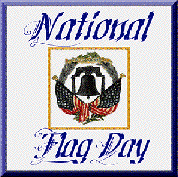June 14: You’re a Grand Old Flag Day
Flag Day (1777)
 It is on this date, June 14, that the United States celebrates Flag Day. June 14 was the date in 1777 that the Continental Congress proposed that the United States should have a national flag instead of the British Union Jack. A century later, on June 14, 1877, the 38-star flag was flown over all government buildings.
It is on this date, June 14, that the United States celebrates Flag Day. June 14 was the date in 1777 that the Continental Congress proposed that the United States should have a national flag instead of the British Union Jack. A century later, on June 14, 1877, the 38-star flag was flown over all government buildings.
Secretary of the Interior Franklin K. Lane delivered a Flag Day address as early as 1914 – on the anniversary of the Flag Resolution of 1777 – but the date was officially established by President Woodrow Wilson on May 30th, 1916. On August 3rd, 1949, President Harry Truman signed an Act of Congress designating June 14th of each year as National Flag Day.
Many other nations have their own Flag Day: The United Kingdom has four, all named after saints: March 1 (St. David’s Day), March 17 (St. Patrick’s Day), April 23 (St. George’s Day) and November 30 (St. Andrew’s Day)! And Canada has two: a national Flag Day on February 15 and a Québec Flag Day, or Jour du Drapeau, on January 21.
It is important to remember that the US flag is not an object of worship, and that Flag Day is not a religious observance. Flag Day is instead a celebration of what the flag represents. Far from being founded on Biblical principles, the United States was the first nation in history to be founded on Enlightenment principles: empiricism, individual rights and science. This trinity of secular principles cannot be found anywhere in Bible, Torah, Koran or any other holy book: they are a human invention, earned through trial and error – not handed to humanity by some divinity.
It is also important to remember that what the flag represents is more important than the physical flag itself. That is why – especially in a country whose Constitution's First Amendment protects nothing if it does not protect political speech – a federal law banning the burning of the flag as a form of protest is clearly unconstitutional, as well as logically contradictory.
Originally published June 2003 by Ronald Bruce Meyer.

